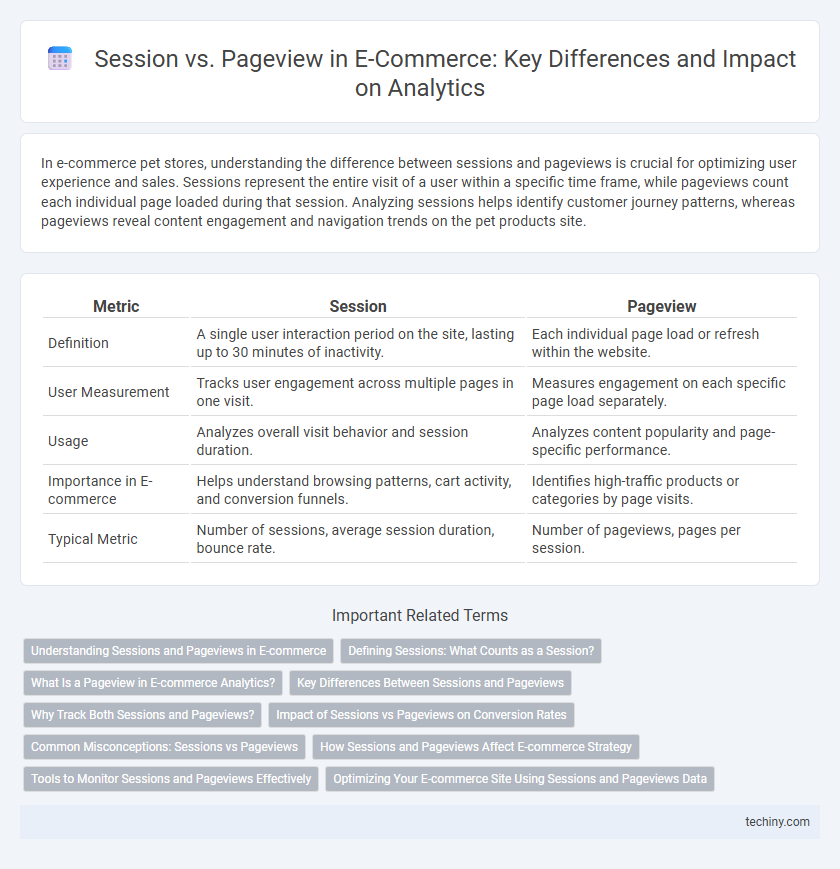In e-commerce pet stores, understanding the difference between sessions and pageviews is crucial for optimizing user experience and sales. Sessions represent the entire visit of a user within a specific time frame, while pageviews count each individual page loaded during that session. Analyzing sessions helps identify customer journey patterns, whereas pageviews reveal content engagement and navigation trends on the pet products site.
Table of Comparison
| Metric | Session | Pageview |
|---|---|---|
| Definition | A single user interaction period on the site, lasting up to 30 minutes of inactivity. | Each individual page load or refresh within the website. |
| User Measurement | Tracks user engagement across multiple pages in one visit. | Measures engagement on each specific page load separately. |
| Usage | Analyzes overall visit behavior and session duration. | Analyzes content popularity and page-specific performance. |
| Importance in E-commerce | Helps understand browsing patterns, cart activity, and conversion funnels. | Identifies high-traffic products or categories by page visits. |
| Typical Metric | Number of sessions, average session duration, bounce rate. | Number of pageviews, pages per session. |
Understanding Sessions and Pageviews in E-commerce
Sessions represent the total number of individual visits to an e-commerce website, capturing user interactions within a specific timeframe, while pageviews count every single page load during those visits. Tracking sessions helps identify user engagement and visit frequency, whereas pageviews measure content consumption and navigation depth. Optimizing both metrics enables e-commerce businesses to enhance user experience, increase conversion rates, and improve site performance.
Defining Sessions: What Counts as a Session?
A session in e-commerce analytics represents a group of user interactions within a specific time frame, typically lasting 30 minutes of inactivity. It starts when a user lands on the website and continues until they leave or remain inactive beyond the session timeout threshold. Understanding sessions is crucial for gauging user engagement, as multiple pageviews can occur within a single session, reflecting the depth of customer interaction.
What Is a Pageview in E-commerce Analytics?
A pageview in e-commerce analytics represents each instance a user loads a specific webpage, capturing vital data on product pages, category pages, and checkout steps. This metric helps track customer engagement, product interest, and website navigation patterns, providing insights into popular items and potential drop-off points. Understanding pageviews enables retailers to optimize site design and improve user experience, directly impacting conversion rates and sales performance.
Key Differences Between Sessions and Pageviews
Sessions represent the total number of individual visits to an e-commerce website, capturing the entire interaction period, while pageviews count each instance a web page is loaded or reloaded during those visits. A single session can include multiple pageviews, reflecting a user's navigation through various products and pages, which helps measure engagement depth. Understanding the distinction is crucial for analyzing user behavior, optimizing site structure, and improving conversion rates in online retail.
Why Track Both Sessions and Pageviews?
Tracking both sessions and pageviews is essential for understanding user behavior in e-commerce, as sessions provide insights into the duration and flow of user interactions while pageviews reveal the popularity and engagement level of individual product pages. Monitoring sessions helps identify conversion funnels and customer journey patterns, whereas analyzing pageviews uncovers which products or content attract the most attention. Combining these metrics enables optimized website design and targeted marketing strategies to boost sales and improve user experience.
Impact of Sessions vs Pageviews on Conversion Rates
Sessions measure individual user visits while pageviews count total pages loaded, both critical metrics in e-commerce analytics for conversion rate optimization. Higher sessions indicate increased visitor engagement frequency, directly correlating with more opportunities for conversions, whereas pageviews reflect user interaction depth, highlighting content effectiveness and product interest. Optimizing for sessions enhances unique user reach, while maximizing pageviews improves funnel progression, collectively driving higher e-commerce conversion rates.
Common Misconceptions: Sessions vs Pageviews
Sessions and pageviews are distinct metrics in e-commerce analytics, often confused by beginners. A session represents a group of user interactions within a specific time frame, while pageviews count each time a page is loaded or reloaded. Misinterpreting pageviews as sessions can lead to inaccurate assessments of user engagement and conversion rates.
How Sessions and Pageviews Affect E-commerce Strategy
Sessions represent the total number of individual visits to an e-commerce website, while pageviews count each time a page is loaded or reloaded within those visits. High session counts indicate strong user engagement and potential customer interest, whereas increased pageviews suggest active browsing but may also highlight navigation issues. Understanding the balance between sessions and pageviews helps e-commerce businesses optimize user experience, improve conversion rates, and tailor marketing strategies effectively.
Tools to Monitor Sessions and Pageviews Effectively
Google Analytics and Adobe Analytics are leading tools for monitoring sessions and pageviews, offering detailed insights into user behavior and engagement metrics. Hotjar and Crazy Egg enhance session tracking by providing heatmaps and session recordings, enabling a deeper understanding of visitor interactions on e-commerce sites. Implementing these tools allows businesses to optimize website performance, improve user experience, and increase conversion rates through data-driven decisions.
Optimizing Your E-commerce Site Using Sessions and Pageviews Data
Analyzing session data offers comprehensive insights into user behavior by tracking the entire visit duration and interactions, enabling targeted improvements in navigation and checkout flow. Pageview metrics provide granular information about individual page performance, helping identify high-traffic pages and optimize content placement for increased engagement. Leveraging both sessions and pageviews data allows e-commerce sites to enhance user experience, boost conversion rates, and refine marketing strategies through data-driven decisions.
Session vs Pageview Infographic

 techiny.com
techiny.com